
Hearthstone
Welcome to the Hearthstone realm!
Skylander: Standard Big Spell/Highlander/Quest Mage
- Highlander Mage
- Wild
- Ranked
Thus far into the Saviors of Uldum meta, the two Mage legendaries Raid the Sky Temple and Reno the Relicologist have taken a back seat to key epics like Tortollan Pilgrim or Puzzle Box of Yogg-Saron. The communal sense, it seems, is that the Legendary Quest itself is rather underwhelming, and the emerging Mage archetype instead relies on stocking up big spells (like the aforementioned Puzzle Box) that can be converted into big bodies by the Neutral legendary King Phaoris.
These decks work because the current proliferation of quests means that games last longer than during the Rise of Shadows meta. The only downside to this setup is that it tends to run out of steam once the trump cards have been played. Especially in match-ups against Warrior or Priest, you're likely looking at the bottom of the deck by the end, and in the Highlander variant, you seldom aren't carrying enough freezes or board clears to meet every threat. Which is where our much maligned Raid the Sky Temple to the rescue!
Core Cards
Why a Highlander deck?
Standard Mage only has two cards that play to the Highlander mechanic: Reno the Relicologist and Zephrys the Great. But both are answers in their own right to elements of the current meta! Against matchups like Murloc Paladin, you often need to deal with a number of threats before you can play Flamestrike on Turn 7. Zephyrs lets you pull those cards from other classes -- Holy Nova and Hellfire are better and earlier answers than Frost Nova.
To offset the fact that you only have one copy of each card, this deck runs a fair amount of spell generation -- Magic Trick or Vulpera Scoundrel let you gamble for fresh tech spells, Arcane Keysmith lets you tack on a new secret, and Tortollan Pilgrim functionally offers you another Blizzard/Frost Nova/Flamestrike or even Luna's Pocket Galaxy on a 5/5 body at no added cost. Kalecgos gives you yet another opportunity to fish. At the bottom of the deck, your spell generation woes are solved by Raid the Sky Temple!
As with any Highlander deck, it is worth noting that this version tips towards the expensive side. But many of the listed legendaries are really being used as Swiss Army Knife solutions to random problems that you're likely to encounter. Because you can't always have multiple answers to a given problem, the trick is to stockpile some cards that offer solutions to lots of different scenarios. Siamat or Zilliax do this better than most. But even a Bone Wraith could get you out of some of the same trouble.
Strategy
There are essentially two "paths" through the deck, with one less favorable alternative, and which path you take depends largely on how soon you draw Luna's Pocket Galaxy and whether or not you have King Phaoris in hand alongside at least two big spells before Turn 10. If you can play Luna's Pocket Galaxy in the first 10 turns -- or ideally when you could first cast in on Turn 5 -- your odds of winning increase significantly. The deck is very heavy on minions, and especially legendary minions. A 1-mana Kalecgos means that you can squeeze off multiple game-altering spells on the same turn, since his actual cost is virtually eliminated. A 1-mana Archmage Antonidas will let you turn several small spells into Fireballs before your opponent can remove him. You basically become a colossal pain for your opponent to fend off at every turn. Luna's: it's not just for Mountain Giants anymore!
This deck runs a ton of freezes, secrets, and stalls. Though you should use these to keep you alive, first and foremost, if you luck into having Luna's ready to go on Turn 5, you should preemptively play one of your stalls to keep you from "wasting" the turn. Unless there's a threat that requires some immediate answer, because of the sheer volume of high-value minions, playing Luna's early is almost always worth the investment.
A non-trivial number of your wins will come from dropping the opponent's health with Alexstrasza or generating Fireballs from Archmage Antonidas that get converted into free damage from Kalecgos.
1) Primary Path - Feed King Phaoris First.
This your principal win condition against most decks. You only want to play King Phaoris when you're carrying at least 2 of your big spells (Pyroblast, Puzzle Box of Yogg-Saron, Power of Creation and maybe Flamestrike and Blizzard if you're desperate) in hand. The number of ten drops that can result from Pyro/Yogg has increased substantially in Uldum. The best case scenario is that one of these nets you Living Monument (a card that no one would ever play for real) and not another Phaoris himself. If you are able to play Luna's Pocket Galaxy before you draw Phaoris, you can pull this off even earlier, often when your opponent doesn't have answers ready. If your opponent has answers, you then need to turn your big spells into things you can play more quickly, pivoting to...
2) Secondary Path - Cheat Out the Big Stuff.
On this path, you're planning to use Naga Sand Witch to drop the cost of the big spells above to 5, so that you can squeeze off more than one in a single turn if possible. Even on Turn 10, Flamestrike + Power of Creation is often difficult for an opponent to answer. With an otherwise emtpy board, flipping the script and running Power of Creation before Puzzle Box of Yogg-Saron will give you two bodies to benefit from any beneficial "friendly" magic Yogg decides to pull out of his box.
Depending on how the cards fall, this might be your path of first resort. If your opponent is closing in, it's now well past Turn 10, and you still haven't seen King Phaoris, it's potentially worth dropping this earlier than you'd otherwise like. The swing that can result from even playing Puzzle Box of Yogg-Saron with just the Sea Witch herself on the board is a better desperation plan than just Yogg itself due to the number of spells that have effects that only hit a "friendly" minion.
3) The Path of Last Resort - Stall.
This deck, and even this path, is extremely potent. The only downside is that it means your matches run very, very, very long. If you're unlucky enough to have King Phaoris, Luna's Pocket Galaxy, and Naga Sea Witch all at the bottom of your deck, you've almost certainly completed your quest (more on that below) and have likely pulled enough defensive spells that you can stay alive well into fatigue. At this point, your only real option is to try to control your opponent's board while spoonfeeding them threats to deal with one by one. Curiously, this strategy is actually effective against classes like Warrior, because it forces them to play out their removal turn after turn after turn without having an answer to the "real" threat when it comes.
Uh... so when do I complete the Quest?
The trick here is to not consciously try to complete the quest. In total you are running 18 spells between the ones in your deck and the ones that can be produced by Magic Trick and Vulpera Scoundrel. If your match runs to 15-20 turns, odds are you will have satisfied Raid the Sky Temple simply by answering whatever is thrown at you. In this deck in particular, however, Raid the Sky Temple is an absolute lifeline. To begin with, you don't have any other 1-drops to play, and Highlander mulligans are notoriously fickle, so nothing is "wasted" by burning your first turn to set the quest up. But when the quest is finished, you now have a steady source of answers that you'd otherwise be lacking. If everything is going according to plan, since half of your deck has now been discounted thanks to Luna's Pocket Galaxy, you'll likely end most turns with a lot of surplus mana. Ascendant Scroll lets you find something to spend it on.
This deck boasts a reasonable win rate, and even so, I'd estimated that I complete the quest only about half the time. But there are matches that I have won exclusively because Ascendant Scroll gave me more freezes than my deck ever carries, or because a Blast Wave pulled from Ascendant Scroll killed my own [Hearthstone Card (Hakkar the Soulflayer) Not Found] when both me and my opponent were in fatigue but his turn was up next. (Yes, this last happened TWICE!)
Match-Ups and Mulligans
Highlander decks are difficult to provide a clear mulligan strategy for, since you're equally likely to draw any one card as any other. The only perpetual keep is Luna's Pocket Galaxy, following closely by Zephrys the Great. All other Legendary minions always get sent back into the deck.
- Warrior. This, bizarrely, is your number one match-up, and I'll provide a breakdown of what my win percentage is when I get the month-end report for August. Look for Luna's Pocket Galaxy and pray that you pull your heavy hitters before Dr. Boom gets going. Tip: Even without Luna's these games run long enough that you can afford to drop just one Legendary threat at a time. This really interferes with anyone running Supercollider, since they're just taking face damage without further collateral. Warning: this game will take forever.
- Paladin. Just assume it's Murloc Paladin. Mulligan for Counterspell and play it on Turn 3. Their only spell is typically the 4-cost Prismatic Lens so if it fails, it sets their whole strategy back several, several turns. This is also one of the few circumstances where I'm comfortable playing Zephrys the Great early, since Hellfire or even the odd Hungry Crab are major slowdowns for them. If you can stop the first Tip the Scales rush, odds are they'll concede before they get off a second. If the Paladin turns out to be Quest Paladin, you don't lose anything in your mulligan strategy.
- Rogue. Structurally similar to Paladin. You have too many ways of slowing them down, and don't drop enough small minions on the board early to get their combo game going.
- Mage. Mulligan for Counterspell or Arcane Keysmith into Mirror Entity to throw off the likely Mountain Giant game.
- Priest. You're likely facing some version of Ahmet/Resurrect/Quest Priest. Treat each the same and play your game. Because you know the game will run long, you can mulligan for early value generators like Vulpera Scoundrel or [Hearthstone Card (Zephyrs the Great) Not Found]. If you answer all of the early board moves, odds are the game will end early. If you happen to be playing Quest Priest, resist the urge to go face; it's just free healing for them. These versions of the class don't seem to run Mass Hysteria nearly as often, so you can occasionally pool a bunch of minions without attacking right away.
- Shaman. Quest Shaman for now seems to have overtaken Murloc Shaman (and thank Yogg for that). Mulligan again for value. Don't let them emote gloat when they complete their quest 12 turns before you.... again, you don't really care.
- Druid. This is likely Quest Druid for the time being. Functionally the same as Shaman, above, including the part about emote gloating.
- Hunter. You will probably lose to Mech Hunter, since this is the one meta setup that tends not to run much longer than 7 turns, and you seldom can afford to play Luna's on Turn 5 because you have to devote your every waking second to keeping the board clear. Secret Hunter is more manageable; the only tricky part is that Secretkeeper benefits from all the secrets you want to play too. To protect myself in either instance, I will often mulligan for Frostbolt and will play it to immediately on Turn 2 to clear a Secretkeeper or mech body, no question whatsoever.
Thanks for reading!
Vote On This Deck!
Enjoy this deck guide? Help others find it and show your support to the author by giving it an upvote!
1- 00
- 01
- 02
- 03
- 04
- 05
- 06
- 07+
- 1 Magic Trick x 1
- 1 Raid the Sky Temple x 1
- 1 Ray of Frost x 1
- 2 Ancient Mysteries x 1
- 2 Frostbolt x 1
- 3 Arcane Intellect x 1
- 3 Counterspell x 1
- 3 Flame Ward x 1
- 3 Frost Nova x 1
- 3 Ice Barrier x 1
- 3 Stargazer Luna x 1
- 4 Arcane Keysmith x 1
- 5 Naga Sand Witch x 1
- 6 Blizzard x 1
- 6 Reno the Relicologist x 1
- 7 Archmage Antonidas x 1
- 7 Flamestrike x 1
- 7 Luna's Pocket Galaxy x 1
- 8 Kalecgos x 1
- 8 Power of Creation x 1
- 8 Tortollan Pilgrim x 1
- 10 Puzzle Box of Yogg-Saron x 1
- 10 Pyroblast x 1
- 2 Zephrys the Great x 1
- 3 Vulpera Scoundrel x 1
- 5 Zilliax x 1
- 6 Khartut Defender x 1
- 7 Siamat x 1
- 9 Alexstrasza x 1
- 10 King Phaoris x 1
More Highlander Mage Decks
More Decks From MisterKnott
Leave a Comment
You must be signed in to leave a comment. Sign in here.

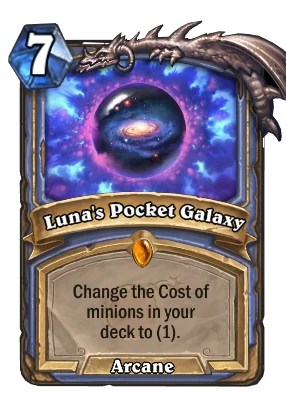
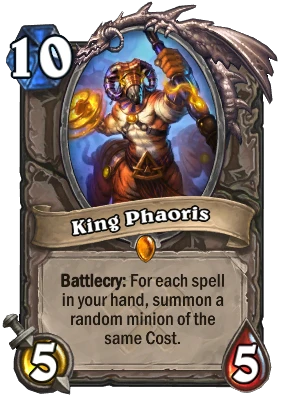

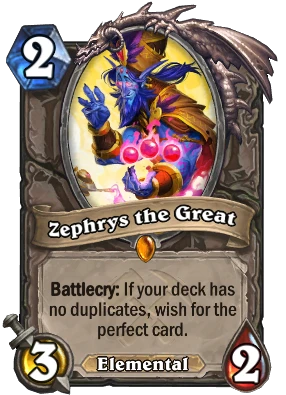
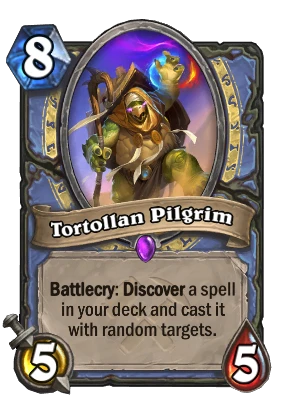
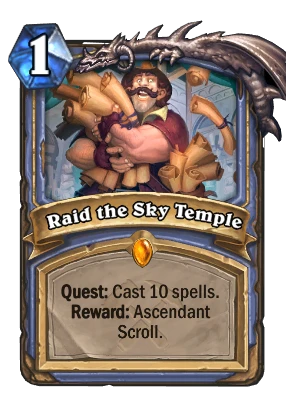
Comments
No Comments Yet. Be the first to create one down below!